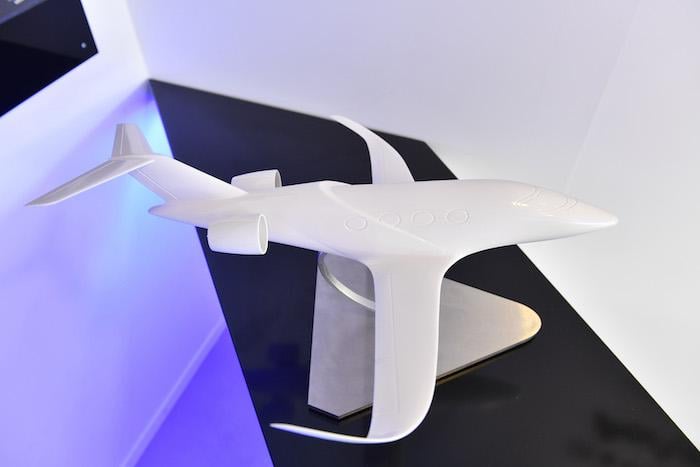
A model of the BYA-1 concept.
LE BOURGET—French startup Beyond Aerospace has unveiled plans to develop a hydrogen fuel-cell-powered business jet, the BYA-1.
The Toulouse-based company plans to begin by flying a subscale fuel-cell powertrain in a two-seat ultralight aircraft.
Beyond Aero is displaying its 85-kW subscale powertrain at the show. The system comprises: pressurized gaseous hydrogen tanks; the fuel cell with its balance of plant; a battery pack to cover peak power and transient; and an electric motor driving a propeller.
The startup aims to certify the four- to eight-seat BYA-1 business jet by 2030, says co-founder and CEO Eloa Guillotin. The aircraft is designed to fly 800 nm at 310 kt. on a fuel-cell system powering two 500-kW electric ducted fans.
“Our goal is to rethink the architecture of a hydrogen powertrain. This is not a retrofit,” she says—a reference to other startups beginning by modifying existing turbine-powered aircraft to fuel-cell propulsion.
In designing a hydrogen-powered business jet, Guillotin says there were two big questions to address: where to position the large, heavy tanks and how to cool the fuel cells. In the BYA-1, the pressurized hydrogen tanks are mounted under the cabin, resulting in a deep fuselage.
The wing is large and thin as there are no fuel tanks inside. The inlet for the fuel-cell cooling air is a half-moon shape that wraps around the upper fuselage. With a maximum takeoff weight of 18,740 lb. the BYA-1 will be certified under European CS-23 regulations.
Beyond Aero was founded in 2020 and has spent the last 18 months developing the subscale powertrain. Supplied by Ekpo, the low-temperature proton exchange membrane fuel cell in the demonstrator will produce a maximum 85 kW of electrical power and 60 kW of shaft power.

The battery system provides 40 kW of electrical power on takeoff to augment the fuel cell’s output as well as covering transient demand and providing a backup power supply to the motor. The production powertrain will have multiple fuel cells, but retain the battery system, Guillotin says.
Beyond Aero is already working with airports on the infrastructure required to ensure low-carbon hydrogen is available to operators of the BYA-1. Guillotin expects aircraft operations to begin with shuttle services between major French and European airports, citing the political, cultural and regulatory environment around sustainability in the region.
The startup has raised €10 million ($11 million) to date from investments and grants, including funding from the government’s France 2030 program. First flight of the subscale powertrain in the G1 Aviation ultralight is being paced by technical progress was well as funding, she says.
